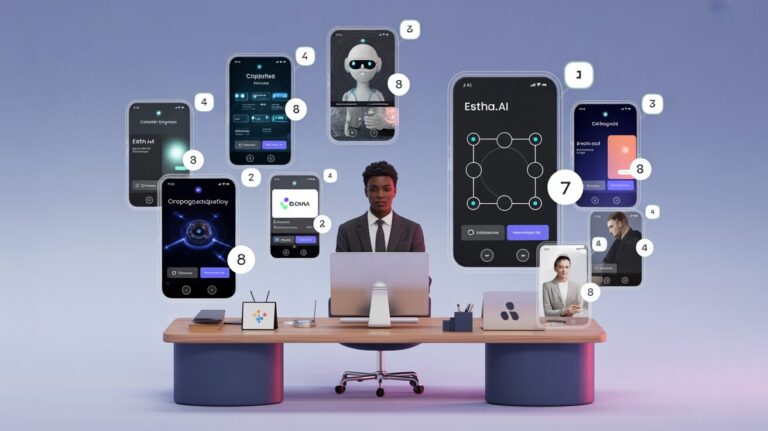Table Of Contents
- Understanding AI Customer Support Bots
- How AI Customer Support Bots Work
- Key Benefits of AI Customer Support Bots
- Common Types of AI Customer Support Bots
- Essential Features of Effective AI Support Bots
- Real-World Applications
- Building an AI Customer Support Bot
- Implementation Best Practices
- Measuring Success
- Conclusion
In today’s fast-paced digital landscape, customer expectations for instant, round-the-clock support continue to rise. Meanwhile, businesses of all sizes are seeking efficient ways to provide exceptional service without escalating costs or overburdening their teams. Enter AI customer support bots—a revolutionary solution that’s transforming how businesses interact with their customers.
Whether you’re a small business owner looking to extend your customer service capabilities, a marketer interested in improving customer engagement, or simply curious about how AI is reshaping business operations, this comprehensive guide will walk you through everything you need to know about AI customer support bots.
We’ll explore what these intelligent assistants are, how they function, the benefits they offer, and most importantly—how anyone can create one without writing a single line of code. By the end of this article, you’ll have a clear understanding of how AI support bots can enhance your customer experience strategy and the straightforward path to implementing one for your business.
AI Customer Support Bots
The Complete Guide
1What Are They?
AI customer support bots are software applications powered by artificial intelligence that simulate conversations with users, understand context, recognize intent, and deliver personalized responses.
2Key Technologies
Natural Language Processing
Interprets human language and extracts meaning from customer messages
Machine Learning
Improves performance over time by analyzing past interactions
Knowledge Base Integration
Connects to information repositories to pull accurate data
3Business Benefits
24/7 Availability
Always-on support across all time zones
Instant Responses
Immediate assistance with zero wait times
Cost Efficiency
Reduces operational costs and scales support
Customer Insights
Generates valuable data from interactions
4Types of Support Bots
- FAQ Bots: Simple bots that handle frequently asked questions
- Transactional Bots: Process orders, bookings, and account changes
- Virtual Assistants: Advanced bots that understand context and perform complex tasks
- Industry-Specific Bots: Specialized for banking, healthcare, e-commerce, etc.
5Build Your Own Bot Without Coding
No-Code Bot Building with Estha
Create a fully functional AI customer support bot in minutes with Estha’s intuitive platform:
- Define your bot’s purpose
- Gather your knowledge base
- Design conversation flows with drag-drop-link
- Deploy to your website, app, or messaging platforms
Get Started Today:
Enhance your customer experience with AI support
Learn more at Estha.ai
Understanding AI Customer Support Bots
AI customer support bots (also known as AI chatbots or virtual assistants) are software applications powered by artificial intelligence that simulate conversations with users. Unlike traditional chatbots that follow rigid, pre-programmed scripts, modern AI support bots use natural language processing (NLP) and machine learning to understand customer inquiries, provide relevant responses, and continuously improve their performance over time.
These digital assistants serve as the first point of contact for customer queries, capable of handling a wide range of interactions—from answering frequently asked questions and troubleshooting common issues to processing simple transactions and escalating complex matters to human agents when necessary.
What sets today’s AI support bots apart from their earlier counterparts is their ability to understand context, recognize intent, and deliver personalized responses that feel increasingly human-like. They’re not just automated response systems; they’re intelligent conversation partners designed to enhance the customer experience while optimizing operational efficiency.
How AI Customer Support Bots Work
At their core, AI customer support bots rely on several key technologies to deliver effective assistance:
Natural Language Processing (NLP)
NLP enables bots to interpret human language, extract meaning from customer messages, and understand the intent behind queries. This technology allows bots to process text-based conversations naturally, regardless of how customers phrase their questions or concerns.
Machine Learning
Through machine learning algorithms, AI support bots improve their performance over time by analyzing past interactions. They learn from successful conversations, identify patterns in customer inquiries, and refine their responses accordingly. This continuous learning process means the bot becomes more effective the more it’s used.
Knowledge Base Integration
Most AI support bots connect to a knowledge base or content repository containing information about products, services, policies, and procedures. This integration allows them to pull accurate, up-to-date information when responding to customer queries, ensuring consistency and reliability.
Dialog Management
Sophisticated AI bots maintain context throughout a conversation, remembering earlier exchanges to provide coherent, contextually appropriate responses. This allows them to handle multi-turn conversations where the meaning of a customer’s message depends on what was previously discussed.
The typical workflow of an AI customer support bot involves receiving a customer query, analyzing its intent, retrieving relevant information from its knowledge base, formulating an appropriate response, and learning from the interaction to improve future engagements.
Key Benefits of AI Customer Support Bots
24/7 Availability
Perhaps the most obvious advantage is round-the-clock support. AI bots don’t sleep, take breaks, or go on vacation, allowing businesses to provide consistent service at all hours. This is particularly valuable for global companies serving customers across different time zones and for addressing urgent issues that arise outside standard business hours.
Instant Response Times
In an era where customers expect immediate assistance, AI bots deliver. They respond to inquiries in seconds, eliminating frustrating wait times. Studies show that 82% of customers consider quick resolution to be the most important element of a positive customer experience, making this speed a significant competitive advantage.
Cost Efficiency
By automating routine inquiries that would otherwise require human attention, AI bots substantially reduce operational costs. A single bot can handle thousands of simultaneous conversations, equivalent to dozens of human agents. This efficiency allows businesses to scale their support operations without proportionally increasing their headcount or budget.
Consistency and Accuracy
Human agents may provide inconsistent information due to knowledge gaps, fatigue, or individual interpretations of company policies. AI bots deliver uniform, accurate responses based on verified information, ensuring customers receive reliable assistance regardless of when or how they reach out.
Valuable Customer Insights
Every interaction with an AI support bot generates data that businesses can analyze to better understand customer needs, identify common issues, and recognize emerging trends. These insights inform product development, marketing strategies, and service improvements, creating a continuous feedback loop for business optimization.
Common Types of AI Customer Support Bots
FAQ Bots
These entry-level bots specialize in answering frequently asked questions. They’re relatively simple to implement but extremely effective at deflecting routine inquiries that would otherwise consume support teams’ time. FAQ bots typically cover topics like business hours, return policies, shipping information, and basic product specifications.
Transactional Bots
More sophisticated than FAQ bots, transactional bots can help customers complete specific actions such as booking appointments, tracking orders, processing returns, or changing account settings. They often integrate with backend systems like CRMs, payment processors, or inventory management software to deliver functional, self-service experiences.
Virtual Assistants
These advanced AI bots serve as comprehensive support agents capable of understanding complex queries, maintaining conversational context, and performing a wide range of tasks. Virtual assistants often combine multiple capabilities—answering questions, processing transactions, troubleshooting problems, and escalating to humans when necessary—to provide end-to-end customer service.
Industry-Specific Bots
Many businesses implement bots tailored to their specific industry, such as banking bots that help with account management, e-commerce bots that assist with product selection, or healthcare bots that facilitate appointment scheduling and medical inquiries. These specialized assistants incorporate domain knowledge and industry-specific vocabularies to address unique customer needs.
Essential Features of Effective AI Support Bots
The most successful AI customer support bots share several key characteristics that enhance their performance and user acceptance:
Conversational Intelligence
Effective bots understand natural language variations, colloquialisms, and even typos. They recognize the intent behind customer messages rather than simply matching keywords, allowing for more natural, flexible interactions. This intelligence enables them to handle the diverse ways customers might phrase similar inquiries.
Personality and Brand Alignment
The best AI support bots embody their company’s brand voice and values. Whether professional and formal or friendly and casual, their communication style remains consistent and appropriate for the brand’s identity. This alignment helps create cohesive customer experiences across all touchpoints.
Seamless Human Handoff
No matter how sophisticated, every AI bot has limitations. When faced with complex issues beyond their capabilities, effective bots gracefully transfer conversations to human agents, providing context and conversation history to ensure smooth transitions. This handoff process should feel seamless to customers, maintaining continuity in their support experience.
Personalization Capabilities
Advanced AI support bots personalize interactions based on customer data, browsing history, past purchases, or support history. By acknowledging customers by name, referencing their previous interactions, and tailoring recommendations to their preferences, these bots create more engaging, relevant experiences.
Multichannel Availability
Today’s customers expect support across multiple channels—websites, mobile apps, social media platforms, messaging services, and more. Versatile AI bots maintain consistent functionality and information across all these channels, allowing customers to engage on their preferred platform without sacrificing service quality.
Real-World Applications
AI customer support bots have found successful applications across various industries:
Retail and E-commerce
Online retailers use AI bots to help customers find products, check availability, track orders, process returns, and answer product-specific questions. These bots often incorporate recommendation engines to suggest complementary items based on browsing behavior or purchase history, increasing average order values while providing helpful service.
Banking and Financial Services
Financial institutions deploy AI bots to assist with balance inquiries, transaction histories, bill payments, and basic financial advice. These secure, authenticated bots provide convenient self-service options for routine banking tasks while maintaining the privacy and security standards essential in financial services.
Healthcare
In healthcare settings, AI support bots help patients schedule appointments, refill prescriptions, access test results, and find appropriate care resources. Some advanced healthcare bots even assist with preliminary symptom assessment, directing patients to appropriate care levels based on their reported symptoms.
Travel and Hospitality
Airlines, hotels, and travel agencies use AI bots to streamline booking processes, manage itinerary changes, answer destination questions, and provide travel recommendations. These bots help travelers navigate complex booking systems and access timely information during their journeys.
Building an AI Customer Support Bot
Traditionally, creating an AI customer support bot required significant technical expertise, substantial development resources, and months of work. However, no-code platforms like Estha have democratized this process, making it accessible to business professionals without coding knowledge.
The No-Code Advantage
With no-code AI platforms, you can build a fully functional customer support bot in minutes rather than months. These platforms provide intuitive interfaces where you can design conversations, define responses, and customize behaviors through visual elements and simple configurations rather than complex code.
Building Your Bot with Estha
Estha’s platform stands out for its drag-drop-link interface that makes AI application building accessible to everyone. Here’s a simplified breakdown of how to create a customer support bot using Estha:
1. Define your bot’s purpose: Determine what customer support functions your bot should handle—answering FAQs, processing simple transactions, or providing product information.
2. Gather your knowledge base: Compile the information your bot needs, including product details, policies, procedures, and common customer questions with their appropriate answers.
3. Design the conversation flow: Using Estha’s visual interface, map out how conversations should progress, from greeting customers to addressing their needs and concluding interactions.
4. Customize your bot’s personality: Adjust your bot’s tone, language, and responses to align with your brand voice, creating a consistent customer experience.
5. Test and refine: Before launching, thoroughly test your bot with various scenarios to ensure it responds appropriately and provides accurate information.
6. Deploy and integrate: Once ready, deploy your bot to your website, app, or messaging platforms, making it available to assist your customers.
The entire process—from concept to deployment—can be completed in as little as 5-10 minutes with Estha’s platform, making advanced AI support accessible even to small businesses and individual entrepreneurs.
Implementation Best Practices
To maximize the effectiveness of your AI customer support bot, consider these implementation strategies:
Start Small and Scale
Begin with a focused scope—perhaps handling your most common customer questions or supporting a specific product line. This approach allows you to perfect your bot’s performance in one area before expanding its capabilities. As you gain confidence and gather data from interactions, gradually increase your bot’s knowledge and responsibilities.
Set Clear Expectations
Transparency builds trust. Make it clear to customers that they’re interacting with an AI assistant, not a human agent. Communicate what your bot can help with and how to reach human support if needed. This clarity prevents frustration and helps customers engage with your bot appropriately.
Regularly Update Your Knowledge Base
Your business evolves, and your support bot should too. Schedule regular reviews of your bot’s knowledge base to add new information, update outdated content, and refine responses based on customer feedback. This maintenance ensures your bot provides accurate, current information at all times.
Monitor and Learn from Interactions
Analyze your bot’s conversations to identify patterns in customer inquiries, common points of confusion, and opportunities for improvement. These insights can guide not only your bot refinement but also broader business decisions around product development, website content, and customer education.
Measuring Success
To evaluate your AI customer support bot’s performance and impact, track these key metrics:
Resolution Rate
What percentage of customer inquiries does your bot successfully resolve without human intervention? A higher resolution rate indicates greater bot effectiveness and stronger return on investment. Aim for continuous improvement in this metric through regular refinements to your bot’s capabilities.
Customer Satisfaction
Measure how satisfied customers are with their bot interactions through post-conversation surveys or feedback mechanisms. This qualitative data helps you understand the customer experience and identify areas for improvement in your bot’s responses or conversation flows.
Conversation Volume
Track how many customer conversations your bot handles over time. Increasing volume suggests growing customer adoption and comfort with your automated support option. This metric also helps quantify the workload your bot is managing on behalf of your human team.
Time Savings
Calculate how much time your support team saves by having routine inquiries handled by your bot. This time can then be redirected to more complex customer issues requiring human expertise and empathy, ultimately improving overall service quality.
By consistently monitoring these metrics, you can demonstrate your AI support bot’s business value and guide strategic decisions about future investments in customer service technology.
Conclusion
AI customer support bots represent a significant opportunity for businesses of all sizes to enhance their customer service capabilities while optimizing operational efficiency. From providing 24/7 availability and instant responses to generating valuable customer insights and reducing support costs, these intelligent assistants deliver multiple benefits that directly impact both customer satisfaction and bottom-line results.
What’s particularly exciting is that this technology is no longer restricted to large enterprises with substantial development resources. Thanks to no-code platforms like Estha, creating a custom AI support bot has become accessible to virtually anyone, regardless of technical background. In just minutes, small business owners, marketers, and customer service professionals can build sophisticated AI assistants tailored to their unique needs and brand voice.
As customer expectations continue to evolve and the demand for instantaneous, personalized service grows, AI support bots will become an increasingly essential component of comprehensive customer experience strategies. By embracing this technology now, businesses position themselves at the forefront of customer service innovation, ready to meet the demands of tomorrow’s consumers.
Whether you’re looking to extend your support hours, reduce response times, or simply provide more consistent service, an AI customer support bot offers a practical, scalable solution—and with today’s no-code platforms, implementation is simpler than you might think.
Ready to Create Your Own AI Customer Support Bot?
Build a custom AI support bot in minutes—no coding required. Estha’s intuitive platform makes it easy to create, deploy, and manage intelligent assistants that reflect your brand voice and expertise.



